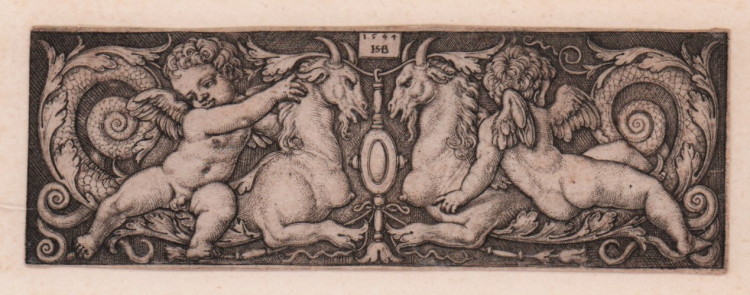



| Reference: | S46687 |
| Author | Hans Sebald BEHAM |
| Year: | 1544 |
| Measures: | 100 x 33 mm |


| Reference: | S46687 |
| Author | Hans Sebald BEHAM |
| Year: | 1544 |
| Measures: | 100 x 33 mm |
Ornamental panel with two genii riding chimeras; animals with snake tails and goat heads face each other in center.
Engraving, 1544, signed with monogram and dated on a tablet at top center.
Example in the second state described by Pauli. The lower part of the left boy's right leg is fully retouched with a crosshatching of lines. The background is also retouched with crosshatching of lines.
Shortly before 1520, some young artists in Albercht Dürer's circle took to making very small engravings that challenged the viewer with a miniature world of new secular subject matter and unconventional interpretations of traditional themes. Because of the small size of their engravings, these artists have long been affixed with the collective, and unflattering, name of Small Nuremberg Masters. The core of the group consists of three artists from Nuremberg, Hans Sebald & Bartel Beham and Georg Pencz, and in addition Jacob Bink from Cologne and Heinrich Aldegrever from Soest.
Good impression, printed on contemporary laid paper, trimmed at the marginal line, in very good condition.
Bibliografia
Pauli 1901-11, Hans Sebald Beham: Ein Kritisches Verzeichniss seiner Kupferstiche Radirungen und Holzschnitte (241.II); Hollstein, German engravings, etchings and woodcuts c.1400-1700 (241.II); Bartsch, Le Peintre graveur (VIII.217.236).
Hans Sebald BEHAM Nuremberg 1500 - Frankfurt 1550
|
Engraver, etcher, designer of woodcuts and stained glass, painter and illustrator. In contemporary documents and prints he was nearly always identified as Sebald Beham although since the 17th century (Sandrart) and into the early years of the 20th he has mistakenly been called Hans Sebald Beham on the basis of his monogram: HSP or HSB. This reflects S[ebald] Peham/Beham with the P (Nuremberg pronunciation) changing to B c. 1531, when he appears to have moved to Frankfurt. Sandrart’s biography of him is illustrated with a printed portrait similar to Sebald’s painted Self-portrait in his David panel in the Louvre; around the Sandrart portrait is an inscription identifying him as painter and engraver. Only one of Sebald’s panel paintings has survived (the Story of David, 1534; Paris, Louvre), though documents cited by Hampe and Vogler refer to him as a journeyman for painting in 1521 and as having his own journeyman—i.e. running a workshop—in 1525. Sebald is best known to posterity, however, for his prints, of which he produced a prodigious quantity: approximately 252 engravings, 18 etchings and 1500 woodcuts, including woodcut book illustrations. Biographical information is scanty: Sandrart alleged that he was trained by Barthel and opened a tavern, the bad reputation of which derived from his own dissolute life. Unquestionably, however, he was industrious and meticulous artistically. He began producing prints in quantity in 1519, though a few date to before then: a woodcut of Lust from a series of the Ten Commandments—a youthfully naive work produced in 1512 when Sebald was 12—and a sheet of sometimes awkwardly drawn pen-and-ink studies of male and female heads on red prepared paper (1518; Brunswick, Herzog Anton Ulrich-Mus.). His first engraving, dated 1518, is a diminutive Portrait of a Young Woman.
|
Hans Sebald BEHAM Nuremberg 1500 - Frankfurt 1550
|
Engraver, etcher, designer of woodcuts and stained glass, painter and illustrator. In contemporary documents and prints he was nearly always identified as Sebald Beham although since the 17th century (Sandrart) and into the early years of the 20th he has mistakenly been called Hans Sebald Beham on the basis of his monogram: HSP or HSB. This reflects S[ebald] Peham/Beham with the P (Nuremberg pronunciation) changing to B c. 1531, when he appears to have moved to Frankfurt. Sandrart’s biography of him is illustrated with a printed portrait similar to Sebald’s painted Self-portrait in his David panel in the Louvre; around the Sandrart portrait is an inscription identifying him as painter and engraver. Only one of Sebald’s panel paintings has survived (the Story of David, 1534; Paris, Louvre), though documents cited by Hampe and Vogler refer to him as a journeyman for painting in 1521 and as having his own journeyman—i.e. running a workshop—in 1525. Sebald is best known to posterity, however, for his prints, of which he produced a prodigious quantity: approximately 252 engravings, 18 etchings and 1500 woodcuts, including woodcut book illustrations. Biographical information is scanty: Sandrart alleged that he was trained by Barthel and opened a tavern, the bad reputation of which derived from his own dissolute life. Unquestionably, however, he was industrious and meticulous artistically. He began producing prints in quantity in 1519, though a few date to before then: a woodcut of Lust from a series of the Ten Commandments—a youthfully naive work produced in 1512 when Sebald was 12—and a sheet of sometimes awkwardly drawn pen-and-ink studies of male and female heads on red prepared paper (1518; Brunswick, Herzog Anton Ulrich-Mus.). His first engraving, dated 1518, is a diminutive Portrait of a Young Woman.
|